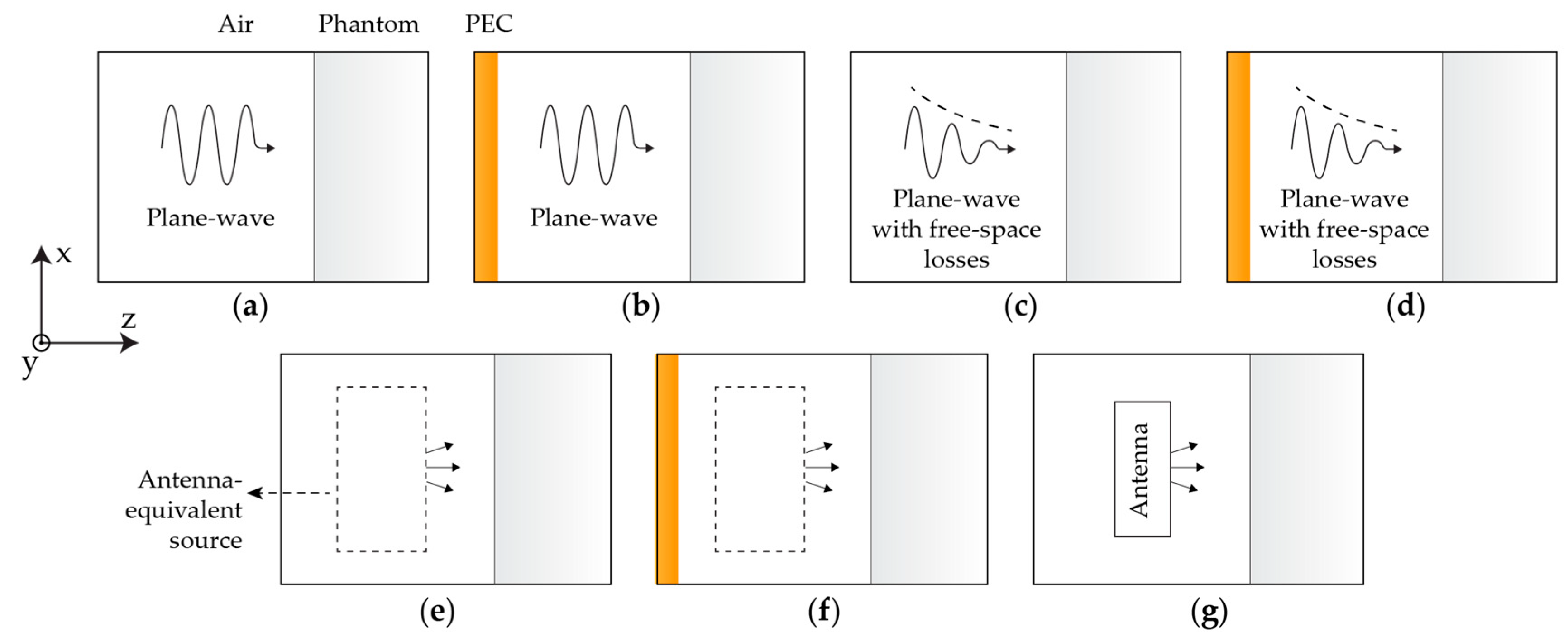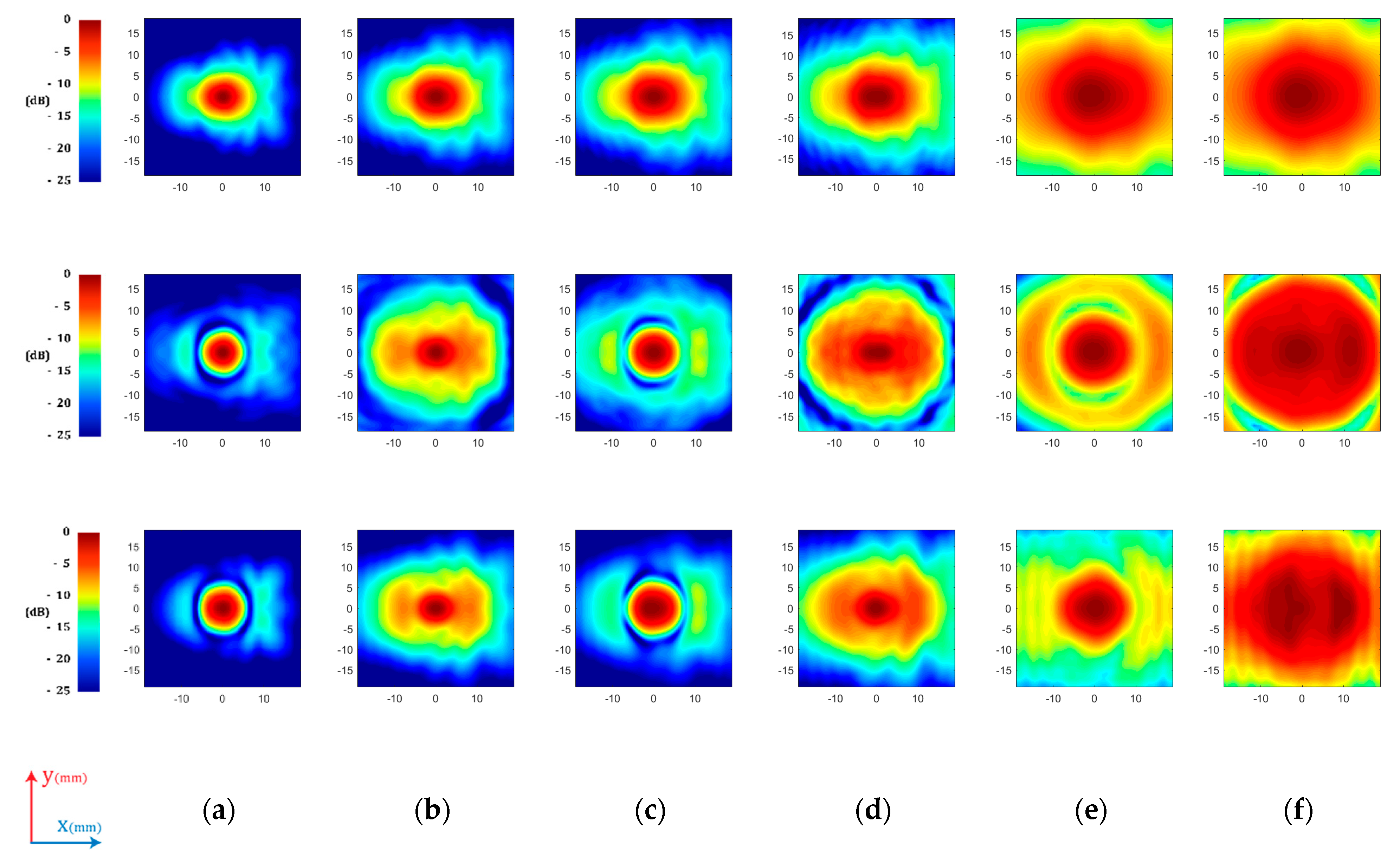Antenna/Body Coupling in the Near-Field at 60 GHz: Impact on the Absorbed Power Density
Abstract
:1. Introduction
2. Materials and Methods
2.1. Exposure Scenarios
- Scenario 1: Plane-wave incident from free space onto a semi-infinite flat skin-equivalent model (Figure 1a).
- Scenario 2: Scenario 1 adding a perfect electric conductor (PEC) parallel to the skin model (Figure 1b).
- Scenario 3: Scenario 1 with free-space losses (i.e., the amplitude of the plane-wave is attenuated in free space) (Figure 1c).
- Scenario 4: Scenario 2 with free-space losses (Figure 1d).
- Scenario 5: Scenario 1 with an antenna equivalent source replacing the plane-wave illumination (Figure 1e).
- Scenario 6: Scenario 2 with the antenna equivalent source replacing the plane-wave illumination (Figure 1f).
- Scenario 7: Realistic antennas placed in the vicinity of the skin model (Figure 1g).
2.2. Analytical Method: Plane Wave Illumination
2.3. Analytical Method: Equivalent Source
2.4. Numerical Method: Patch Antenna Arrays
3. Results
3.1. Fundamental Limits: Plane-Wave Illumination
3.2. Fundamental Limits: Equivalent Sources
3.3. Patch Antenna Arrays
4. Conclusions
Author Contributions
Funding
Acknowledgments
Conflicts of Interest
Appendix A
Appendix A.1. Scenario 2
Appendix A.2. Scenario 4
Appendix A.3. Scenario 6
References
- Dehos, C.; González, J.L.; De Domenico, A.; Kténas, D.; Dussopt, L. Millimeter-wave access and backhauling: The solution to the exponential data traffic increase in 5G mobile communications systems? IEEE Commun. Mag. 2014, 52, 88–95. [Google Scholar] [CrossRef]
- Baykas, T.; Sum, C.-S.; Lan, Z.; Wang, J.; Rahman, M.A.; Harada, H.; Kato, S. IEEE 802.15.3c: The first IEEE wireless standard for data rates over 1 Gb/s. IEEE Commun. Mag. 2011, 49, 114–121. [Google Scholar] [CrossRef]
- Wells, J. Faster than fiber: The future of multi-G/s wireless. IEEE Microw. Mag. 2009, 10, 104–112. [Google Scholar] [CrossRef]
- Beyond 2020 Heterogeneous Wireless Network with Millimeter Wave Small Cell Access and Backhauling | MiWaveS Project | FP7 | CORDIS | European Commission. Available online: https://cordis.europa.eu/project/id/619563/fr (accessed on 14 September 2020).
- Frascolla, V.; Faerber, M.; Dussopt, L.; Calvanese-Strinati, E.; Sauleau, R.; Kotzsch, V.; Romano, G.; Ranta-Aho, K.; Putkonen, J.; Valino, J. Challenges and opportunities for millimeter-wave mobile access standardisation. In Proceedings of the 2014 IEEE Globecom Workshops (GC Wkshps), Austin, TX, USA, 8–12 December 2014; pp. 553–558. [Google Scholar]
- International Commission on Non-Ionizing Radiation Protection (ICNIRP)1 Guidelines for Limiting Exposure to Electromagnetic Fields (100 kHz to 300 GHz). Health Phys. 2020, 118, 483–524. [CrossRef] [PubMed]
- IEEE Standard for Safety Levels with Respect to Human Exposure to Electric, Magnetic, and Electromagnetic Fields, 0 Hz to 300 GHz. In Proceedings of the IEEE Std C95.1-2019 (Revision of IEEE Std C95.1-2005/ Incorporates IEEE StdC95.1-2019/Cor 1-2019), Piscataway, NJ, USA, 22 November 2019; pp. 1–312.
- Zhadobov, M.; Chahat, N.; Sauleau, R.; Le Quement, C.; Le Drean, Y. Millimeter-wave interactions with the human body: State of knowledge and recent advances. Int. J. Microw. Wirel. Technol. 2011, 3, 237–247. [Google Scholar] [CrossRef] [Green Version]
- Zhadobov, M.; Sauleau, R.; Le Drean, Y.; Alekseev, S.I.; Ziskin, M.C. Numerical and experimental approaches to millimeter-wave dosimetry for in vitro experiments. In Proceedings of the 2008 33rd International Conference on Infrared, Millimeter and Terahertz Waves, Pasadena, CA, USA, 15–19 September 2008; pp. 1–2. [Google Scholar]
- Chahat, N.; Zhadobov, M.; Le Coq, L.; Alekseev, S.I.; Sauleau, R. Characterization of the Interactions Between a 60-GHz Antenna and the Human Body in an Off-Body Scenario. IEEE Trans. Antennas Propag. 2012, 60, 5958–5965. [Google Scholar] [CrossRef]
- Zhadobov, M.; Guraliuc, A.; Chahat, N.; Sauleau, R. Tissue-equivalent phantoms in the 60-GHz band and their application to the body-centric propagation studies. In Proceedings of the 2014 IEEE MTT-S International Microwave Workshop Series on RF and Wireless Technologies for Biomedical and Healthcare Applications (IMWS-Bio2014), London, UK, 8–10 December 2014; pp. 1–3. [Google Scholar]
- Pfeifer, S.; Carrasco, E.; Crespo-Valero, P.; Neufeld, E.; Kuhn, S.; Samaras, T.; Christ, A.; Capstick, M.H.; Kuster, N. Total Field Reconstruction in the Near Field Using Pseudo-Vector E-Field Measurements. IEEE Trans. Electromagn. Compat. 2018, 61, 476–486. [Google Scholar] [CrossRef]
- Noren, P.; Foged, L.J.; Scialacqua, L.; Scannavini, A. Measurement and Diagnostics of Millimeter Waves 5G Enabled Devices. In Proceedings of the 2018 IEEE Conference on Antenna Measurements & Applications (CAMA), Vasteras, Sweden, 3–6 September 2018; pp. 1–4. [Google Scholar]
- Nesterova, M.; Nicol, S. Analytical Study of 5G Beamforming in the Reactive Near-Field Zone. In Proceedings of the 12th European Conference on Antennas and Propagation (EuCAP 2018), London, UK, 9–13 April 2018; pp. 1–5. [Google Scholar]
- Derat, B.; Cozza, A.; Bolomey, J.-C. Influence of source-phantom multiple interactions on the field transmitted in a flat phantom. In Proceedings of the 2007 18th International Zurich Symposium on Electromagnetic Compatibility, Munich, Germany, 24–28 September 2007; pp. 139–142. [Google Scholar] [CrossRef]
- Derat, B.; Cozza, A. Analysis of the transmitted field amplitude and SAR modification due to mobile terminal flat phantom multiple interactions. In Proceedings of the 2nd European Conference on Antennas and Propagation (EuCAP 2007), Edinburgh, UK, 11–16 November 2007; p. 186. [Google Scholar]
- Nakae, T.; Funahashi, D.; Higashiyama, J.; Onishi, T.; Hirata, A. Skin Temperature Elevation for Incident Power Densities From Dipole Arrays at 28 Ghz. IEEE Access 2020, 8, 26863–26871. [Google Scholar] [CrossRef]
- Guraliuc, A.R.; Zhadobov, M.; Sauleau, R.; Marnat, L.; Dussopt, L. Near-Field User Exposure in Forthcoming 5G Scenarios in the 60 GHz Band. IEEE Trans. Antennas Propag. 2017, 65, 6606–6615. [Google Scholar] [CrossRef]
- Colombi, D.; Thors, B.; Tornevik, C.; Balzano, Q. RF Energy Absorption by Biological Tissues in Close Proximity to Millimeter-Wave 5G Wireless Equipment. IEEE Access 2018, 6, 4974–4981. [Google Scholar] [CrossRef]
- Guraliuc, A.R.; Zhadobov, M.; Chahat, N.; Sauleau, R.; Leduc, C. Antenna/human body interactions in the 60 GHz band: State of knowledge and recent advances. In Advances in Body-Centric Wireless Communication: Applications and State-of-the-Art; Institution of Engineering and Technology: London, UK, 2016; pp. 97–142. [Google Scholar]
- Chahat, N.; Zhadobov, M.; Sauleau, R. Broadband Tissue-Equivalent Phantom for BAN Applications at Millimeter Waves. IEEE Trans. Microw. Theory Tech. 2012, 60, 2259–2266. [Google Scholar] [CrossRef]
- Guraliuc, A.; Zhadobov, M.; Sauleau, R.; Marnat, L.; Dussopt, L. Millimeter-wave electromagnetic field exposure from mobile terminals. In Proceedings of the 2015 European Conference on Networks and Communications (EuCNC), Paris, France, 29 June–2 July 2015; pp. 82–85. [Google Scholar]
- Gabriel, S.; Lau, R.W.; Gabriel, C. The dielectric properties of biological tissues: II. Measurements in the frequency range 10 Hz to 20 GHz. Phys. Med. Biol. 1996, 41, 2251–2269. [Google Scholar] [CrossRef] [PubMed] [Green Version]
- LeDuc, C.; Zhadobov, M. Impact of Antenna Topology and Feeding Technique on Coupling With Human Body: Application to 60-GHz Antenna Arrays. IEEE Trans. Antennas Propag. 2017, 65, 6779–6787. [Google Scholar] [CrossRef]
- Pozar, D.M. Microwave Engineering, 4th ed.; Wiley: Hoboken, NJ, USA, 2012. [Google Scholar]
- Cozza, A.; Derat, B. On the Dispersive Nature of the Power Dissipated Into a Lossy Half-Space Close to a Radiating Source. IEEE Trans. Antennas Propag. 2009, 57, 2572–2582. [Google Scholar] [CrossRef] [Green Version]
- Scott, C. The Spectral Domain Method in Electromagnetics; Artech House: Norwood, MA, USA, 1989. [Google Scholar]
- Gregson, S.; McCormick, J.; Parini, C. Principles of Planar Near-Field Antenna Measurements; The Institution of Engineering and Technology, Michael Faraday House, Six Hills Way; IET: Stevenage, UK, 2007. [Google Scholar]
- Sacco, G.; Pisa, S.; Zhadobov, M. Age-dependence of electromagnetic power and heat deposition in near-surface tissues in emerging 5G bands. Sci. Rep. 2020. submitted. [Google Scholar]
- Balanis, C.A. Antenna Theory: Analysis and Design, 4th ed.; Wiley: Hoboken, NJ, USA, 2016. [Google Scholar]
- Hislop, P.D.; Sigal, I.M. Introduction to Spectral Theory; Springer: New York, NY, USA, 1996; p. 310. [Google Scholar]










| 1 | 3 | 5 | |
|---|---|---|---|
| 3.21 | 2.14 | 1.61 | |
| 0.43 | 1.40 | 1.59 |
| 1 | 3 | 5 | ||
|---|---|---|---|---|
| 1.41 | 1.15 | 1.05 | ||
| 0.75 | 0.99 | 1.05 |
| SPA | 2 × 2 PAA | 2 × 4 PAA | 4 × 4 PAA | |||||||||
|---|---|---|---|---|---|---|---|---|---|---|---|---|
| 1 | 3 | 5 | 1 | 3 | 5 | 1 | 3 | 5 | 1 | 3 | 5 | |
| 2.29 | 1.56 | 1.37 | 3.08 | 1.89 | 1.58 | 3.31 | 2.08 | 1.69 | 3.47 | 2.24 | 1.76 | |
| 0.76 | 1.13 | 1.20 | 0.59 | 1.13 | 1.19 | 0.58 | 1.13 | 1.20 | 0.59 | 1.14 | 1.21 | |
| SPA | 2 × 2 PAA | 2 × 4 PAA | 4 × 4 PAA | |||||||||
|---|---|---|---|---|---|---|---|---|---|---|---|---|
| 1 | 3 | 5 | 1 | 3 | 5 | 1 | 3 | 5 | 1 | 3 | 5 | |
| 1.51 | 1.20 | 1.10 | 1.47 | 1.22 | 1.14 | 1.52 | 1.25 | 1.21 | 1.37 | 1.12 | 1.12 | |
| 0.74 | 0.99 | 1.04 | 0.73 | 0.98 | 1.03 | 0.82 | 1.08 | 1.11 | 0.78 | 1.00 | 1.03 | |
Publisher’s Note: MDPI stays neutral with regard to jurisdictional claims in published maps and institutional affiliations. |
© 2020 by the authors. Licensee MDPI, Basel, Switzerland. This article is an open access article distributed under the terms and conditions of the Creative Commons Attribution (CC BY) license (http://creativecommons.org/licenses/by/4.0/).
Share and Cite
Ziane, M.; Sauleau, R.; Zhadobov, M. Antenna/Body Coupling in the Near-Field at 60 GHz: Impact on the Absorbed Power Density. Appl. Sci. 2020, 10, 7392. https://doi.org/10.3390/app10217392
Ziane M, Sauleau R, Zhadobov M. Antenna/Body Coupling in the Near-Field at 60 GHz: Impact on the Absorbed Power Density. Applied Sciences. 2020; 10(21):7392. https://doi.org/10.3390/app10217392
Chicago/Turabian StyleZiane, Massinissa, Ronan Sauleau, and Maxim Zhadobov. 2020. "Antenna/Body Coupling in the Near-Field at 60 GHz: Impact on the Absorbed Power Density" Applied Sciences 10, no. 21: 7392. https://doi.org/10.3390/app10217392
APA StyleZiane, M., Sauleau, R., & Zhadobov, M. (2020). Antenna/Body Coupling in the Near-Field at 60 GHz: Impact on the Absorbed Power Density. Applied Sciences, 10(21), 7392. https://doi.org/10.3390/app10217392





